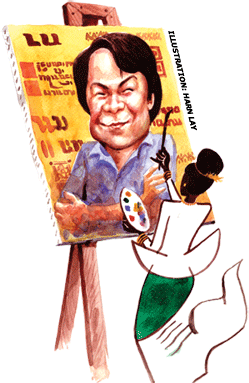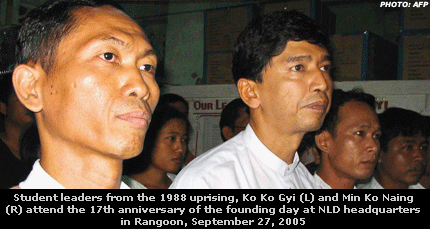Magazine
COVER STORY
The Faces of Burma 2005
By The Irrawaddy
DECEMBER, 2005 - VOLUME 13 NO.12
(Page 2 of 13)
After successful lobbying, the director filmed The Night of the Ghost Busters, a movie aimed at both domestic and international audiences.
 Nay Myo Say [Artist]
Nay Myo Say [Artist]Renowned Rangoon painter Nay Myo Say, who studied under impressionist master U Lun Gywe, has developed a unique style, setting him apart from others of his generation. Now in his late thirties, Nay Myo Say recently won great acclaim for “Dancers,” a series of mixed collages in which he captures the essence of classical Burmese dance and religious devotion.
Using original black and white photographs and several layers of fluid acrylic paint, the collages portray a young female dancer performing and offering prayers to Buddha. Nay Myo Say says his work is a kind of “Natri Puja”, a Pali term meaning to worship through art. Since 1995, Nay Myo Say’s art work has been exhibited in Burma and abroad in Singapore, Indonesia and London.
88-Generation Students Group [Burmese Student Leaders]
In early September, a group of former Burmese student leaders, under the name 88-Generation Students, called for cooperation between the ruling military junta and opposition parties to create the right environment for attracting and coordinating the flow of international humanitarian aid to people in distress.
A statement issued by the group—comprising well-known former political prisoners such as Min Ko Naing, Ko Ko Gyi, Htay Kywe, Min Zeya and Zaw Min—came out about a month after the withdrawal of international aid donor Global Fund from Burma, where HIV/AIDS, TB and malaria remain potentially pandemic threats to the country’s population.
Min Ko Naing, the group’s leader, emphasized that while national reconciliation is still a priority in resolving the country’s fundamental problems, the group believes that finding common ground among all concerned parties in Burma to address humanitarian crises would provide a window of opportunity for further cooperation and eventual reconciliation.

Almost all political groups inside and outside Burma welcomed the group’s statement. Paulo Sergio Pinheiro, the UN’s special rapporteur for human rights in Burma, said that the 88-Generation Students’ statement “must be warmly welcomed” in an address to the 60th session of the UN General Assembly in New York on October 27.
Burma’s ruling junta, however, brushed the statement off in a press conference in October. Burma’s Minister of Information Brig-Gen Kyaw Hsan dismissed it as an attempt by student leaders to make a name for themselves. He added: “It was aimed at attacking the Government by the internal and external destructive elements in synchronization, as if they were eager to serve the public interests.”
Since then, the student group has felt increasing pressure from authorities. Ko Ko Gyi, considered the chief strategist of the group, refused to make any comment on the regime’s hostile reaction. “We don’t want to get into a tit-for-tat vicious cycle,” Ko Ko Gyi told The Irrawaddy.
Many observers, including foreign experts, consider the actions of the 88-Generation Students mature and significant. Many also suspect that the group will play a major role in breaking the country’s political deadlock. In addition, the group has taken on numerous civic responsibilities. Student leaders frequently visit family members of political prisoners to give moral support. In recent months, members of the group have participated in political events sponsored by the National League for Democracy, attended the trial of human rights activist Su Su Nway, and contributed to social activities such as book fairs and art exhibitions.
Min Ko Naing [Student Leader]
Min Ko Naing, the most prominent leader of the 88-Generation Students, and one of The Irrawaddy’s People of 2004, has been further recognized by the international community in 2005 with the awarding of the 2005 Civil Courage Prize by the Trustees of the Northcote Parkinson Fund.
The award was given for his “steadfast resistance to evil at great personal risk.” Min Ko Naing, who endured 15 years of imprisonment by the military junta until his release in November 2004, could not attend the award ceremony, but he sent a personal message that was conveyed via several exiled media groups.
Min Ko Naing told The Irrawaddy that the people of Burma must have the courage to say no to injustice and yes to the truth. They must also work to correct their own wrongdoing that hurts society.
« previous 1 | 2 | 3 | 4 | 5 | 6 | 7 | 8 | 9 | 10 | 11 | 12 | 13 next page »
more articles in this section
